ads
Fox News Breaking News Alert
Up to 4,000 US troops could deploy to Middle East amid Baghdad unrest, officials say
12/31/19 3:17 PM
Fox News Breaking News Alert
Trump blames Iran for US Embassy attack in Iraq, vows to hold regime ‘fully responsible’
12/31/19 4:32 AM
New world news from Time: Protestors Breach U.S. Embassy Compound in Baghdad
(BAGHDAD) — Dozens of Iraqi Shiite militiamen and their supporters broke into the U.S. Embassy compound in Baghdad on Tuesday, smashing a main door and setting fire to a reception area, prompting tear gas and sounds of gunfire, angered over deadly U.S. airstrikes targeting the Iran-backed militia.
An Associated Press reporter at the scene saw flames rising from inside the compound and at least three U.S. soldiers on the roof of the main embassy building. There was a fire at the reception area near the parking lot of the compound but it was unclear what had caused it. A man on a loudspeaker urged the mob not to enter the compound, saying: “The message was delivered.”
There were no reports of casualties, but the unprecedented breach was one of the worst attacks on the embassy in recent memory. It followed deadly U.S. airstrikes on Sunday that killed 25 fighters of the Iran-backed militia in Iraq, the Kataeb Hezbollah. The U.S. military said the airstrikes were in retaliation for last week’s killing of an American contractor in a rocket attack on an Iraqi military base that it had blamed on the militia.
The developments represent a major downturn in Iraq-U.S. relations that could further undermine U.S. influence in the region and also weaken Washington’s hand in its maximum pressure campaign against Iran.
Iraq has long struggled to balance its ties with the U.S. and Iran, both allies of the Iraqi government. But the government’s angry reaction to the U.S. airstrikes and its apparent decision not to prevent the protesters from reaching the embassy signaled a sharp deterioration of U.S.-Iraq relations.

Iraqi security forces made no effort to stop the protesters as they marched to the heavily-fortified Green Zone after a funeral held for those killed in the U.S. airstrikes, letting them pass through a security checkpoint leading to the area.
Dozens of protesters pushed into the embassy compound after smashing the gate used by cars to enter the embassy. The protesters, many in militia uniform, stopped in a corridor after about 5 meters (16 feet), and were only about 200 meters away from the main building. Half a dozen U.S. soldiers were seen on the roof of the main building, their guns were pointed at the protesters.
Smoke from the tear gas rose in the area, and at least three of the protesters appeared to have difficulties breathing. It wasn’t immediately known whether the embassy staff had remained inside the main building or were evacuated at some point. There was no immediate comment from the U.S. Embassy.
The protesters hanged a poster on the wall: “America is an aggressor,” and some commanders of militia factions loyal to Iran joined the protesters. Among those was Hadi al-Amiri, the head of the state-sanctioned paramilitary Popular Mobilization Units, the umbrella group for the Iran-backed militias.
Yassine al-Yasseri, Iraq’s interior minister, also appeared outside the embassy at one point and walked around to inspect the scene. He told the AP that the prime minister had warned the U.S. strikes on the Shiite militiamen would have serious consequences. “This is one of the implications,” al-Yasseri said. “This is a problem and is embarrassing to the government.”
He said more security will be deployed to separate the protesters from the embassy, an indication the Iraqi troops would not move in to break up the crowd by force.
Earlier, the mob shouted “Down, Down USA!” as the crowd tried to push inside the embassy grounds, hurling water and stones over its walls. They raised yellow militia flags and taunted the embassy’s security staff who remained behind the glass windows in the gates’ reception area and also sprayed graffiti on the wall and windows. The graffiti, in red in support of the Kataeb Hezbollah, read: “Closed in the name of the resistance.”
Hundreds of angry protesters set up tents outside the embassy. As tempers rose, the mob set fire to three trailers used by security guards along the embassy wall. No one was immediately reported hurt, and security staff had withdrawn to inside the embassy earlier, soon after protesters gathered outside.

Seven armored vehicles with about 30 Iraqi soldiers arrived near the embassy hours after the violence erupted, deploying near the embassy walls but not close to the breached area. Four vehicles carrying riot police approached the embassy later but were forced back by the protesters who blocked their path.
There was no immediate comment from the Pentagon and the State Department.
The U.S. airstrikes — the largest targeting an Iraqi state-sanctioned militia in recent years — and the subsequent calls by the militia for retaliation, represent a new escalation in the proxy war between the U.S. and Iran playing out in the Middle East. U.S. Secretary of State Mike Pompeo said Sunday’s strikes send the message that the U.S. will not tolerate actions by Iran that jeopardize American lives.
The Iranian-backed Iraqi militia had vowed Monday to retaliate for the U.S. military strikes. The attack and vows for revenge raised concerns of new attacks that could threaten American interests in the region.
The U.S. attack also outraged both the militias and the Iraqi government, which said it will reconsider its relationship with the U.S.-led coalition — the first time it has said it will do so since an agreement was struck to keep some U.S. troops in the country. It called the attack a “flagrant violation” of its sovereignty.
In a partly televised meeting Monday, Caretaker Iraqi Prime Minister Adel Abdul-Mahdi told Cabinet members that he had tried to stop the U.S. operation “but there was insistence” from American officials. He declared three days of mourning for those killed in the U.S. strikes, starting Tuesday.
The U.S. military said “precision defensive strikes” were conducted against five sites of Kataeb Hezbollah, or Hezbollah Brigades in Iraq and Syria. The group, which is a separate force from the Lebanese militant group Hezbollah, operates under the umbrella of the state-sanctioned militias known collectively as the Popular Mobilization Forces. Many of them are supported by Iran.
Fox News Breaking News Alert
Dozens break into US Embassy compound in Baghdad, AP reports
12/31/19 2:12 AM
Fox News Breaking News Alert
Crowd attempts to storm US Embassy in Baghdad, report says
12/31/19 1:20 AM
Fox News Breaking News Alert
Suspect in anti-Semitic attack at New York rabbi’s home charged with federal hate crimes
12/30/19 9:50 AM
Fox News Breaking News Alert
PICTURED: See the hero ex-FBI agent who stopped the Texas church gunman
12/30/19 8:17 AM
Fox News Breaking News Alert
New York Giants fire head coach Pat Shurmur after disappointing season: reports
12/30/19 6:17 AM
Fox News Breaking News Alert
Rep. John Lewis, longtime congressman and civil rights leader, diagnosed with stage 4 pancreatic cancer
12/29/19 3:15 PM
Fox News Breaking News Alert
NYC Mayor de Blasio joins Ed Henry on 'America's News HQ' for exclusive interview
12/29/19 9:30 AM
Fox News Breaking News Alert
Suspect in stabbing at NY rabbi's home arrested on attempted murder, byrglary charges
12/29/19 7:41 AM
New best story on Hacker News: Ask HN: Best books you read in the past decade?
613 by Anon84 | 307 comments on Hacker News.
Now that the decade is coming to a close, what where the most (personally) influential books you read? Which impacted you the most either personally or professionally? The ones you learned the most from?
Fox News Breaking News Alert
New York synagogue stabbing attack results in several injuries: reports
12/28/19 7:52 PM
Fox News Breaking News Alert
Plane with 6 people on board crashes in Lafayette, La.
12/28/19 8:13 AM
Fox News Breaking News Alert
Wreckage of Hawaii tour helicopter carrying 7 has been found, search continues for survivors, officials say
12/27/19 2:23 PM
New world news from Time: North Korea’s ‘Christmas Gift’ Statement Put the U.S. on Alert Despite No Missile Launch. That May Be the Point
North Korea’s “Christmas gift” for the United States never arrived, although it still could.
The ominous statement from a North Korean official that “it is entirely up to the U.S. what Christmas gift it will get” had the U.S. and its allies on alert this week. Many observers predicted the North was preparing to test its first intercontinental ballistic missile (ICBM) since 2017. Since then, President Donald Trump and North Korean leader Kim Jong-un have temporarily ratcheted down tensions with face-to-face meetings. They are beginning to rise again.
Christmas came and went without a launch. Analysts say North Korea may still fire a missile. But, some say, the heightened anxiety over the North’s actions could be the point of the message.
Jenny Town, managing editor of the North Korea research group 38 North, notes that the “Christmas gift” comment was made by a lower-level official. “It wouldn’t have been uncharacteristic for them to do something like this [an ICBM test], but this was hyped up more than it should have been,” she says.
Mintaro Oba, a former U.S. State Department official who specialized in the Koreas, says the ominous statement was a “public communications tactic.”
“It tried to heighten the fear of increased tension in a language Americans would latch onto,” he says.
Earlier this month, North Korea’s vice minister of foreign affairs in charge of U.S. affairs, “reminded” the U.S. that the North had set an arbitrary deadline of the end of 2019 for progress on nuclear talks.
“[North Korea] has done its utmost with maximum perseverance not to backtrack from the important steps it has taken on its own initiative,” the official, Ri Thae Song, said in a statement on North Korea’s state news agency. “What is left to be done now is the U.S. option and it is entirely up to the U.S. what Christmas gift it will select to get.”
Perhaps in response, Aircraft Spots, which tracks U.S. military aircraft movements, found numerous U.S. surveillance aircraft flights over and around the Korean peninsula this week, including on Christmas Day. Among them: an RQ-4 Global Hawk drone; an E-8C Joint STARS ground surveillance plane; a RC-135S Cobra Ball, which is designed to detect ballistic missile launches; and a U.S. Navy P-3C Orion maritime surveillance aircraft, which can hunt submarines.
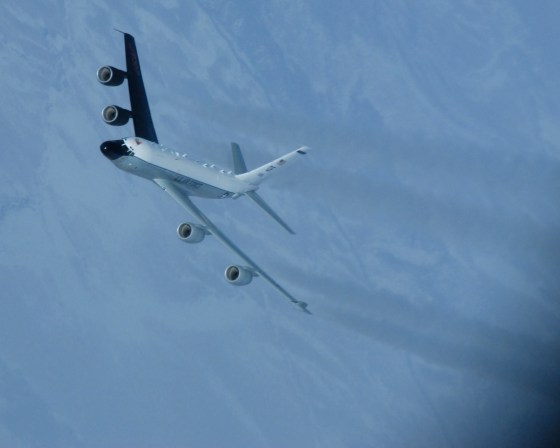
U.S. officials remain watchful. Before the year is over, Kim is expected to chair a year-end conference with his party and give a New Year’s speech. Both are opportunities that the leader could use to claim that he is working — successfully — to advance relations with the U.S.
Despite three meetings between Trump and Kim, talks over the hermit nation’s nuclear program appear to have stalled. The North has fired multiple shorter-range missiles this year with minimal response from the U.S. Analysts said North Korean leaders might expect that an ICBM launch would force the U.S. back to the negotiating table on more favorable terms.

The anticipation of an ICBM launch sparked fears that the New Year could see a return to the “fire and fury” rhetoric of 2017, when Washington and Pyongyang exchanged hostile threats as North Korea ramped up development of its nuclear and long-range missile arsenal.
Even if no test comes before the New Year, analysts say it is likely that the U.S. and its allies remain on high alert. Recent satellite images showed that Pyongyang is expanding a factory linked to the production of long-range nuclear missiles, and increased activity at North Korea’s main nuclear facility was reported last month.
“Scientists and engineers are working on North Korea’s weapons programs every day,” says Daniel Pinkston, a security and international relations expert at Troy University. “And I don’t see any signs or indications that they will stop.”
South Korea’s Yonhap News Agency reported Friday that North Korean media has been touting satellite launches in other countries, and might use the guise of a satellite launch to test an ICBM. Since the technology used for a satellite launch and an ICBM test is similar, Pinkston says, such a test could be used to refine their ICBM program.
Trump, who has bragged about his personal relationship with Kim, brushed off the “Christmas gift” comment. “Maybe it’s a present where he sends me a beautiful vase as opposed to a missile test,” he joked.
Fox News Breaking News Alert
Almaty airport says 9 killed in Kazakhstan plane crash
12/26/19 8:45 PM
Fox News Breaking News Alert
Lawyer for House Democrats says Trump could be impeached again amid court battle over testimony by ex-White House counsel Don Mc
12/23/19 12:28 PM
New world news from Time: 20 Ways the World Got Better in 2019, in Charts
The last 12 months have felt chaotic, destabilizing, and on occasion apocalyptic. Toxic nationalist movements have risen across the globe; politics in democratic nations have increasingly polarized; wealth gaps continue to expand; and the specter of climate change lurking at a remove has become an actual monster inside the house.
It’s difficult, in the context of the daily onslaught of bad news and its demands on our attention, to remember that when you look at the long arc of human civilization, there are many, many things that continue to get better. As a sort of balm for the pains of a traumatic year, here are 20 concrete examples showing how, in many ways, the best time to be a human living on Earth was 2019.
Editor’s note: It often takes a year or two (or more) to collect global data, so some of the figures shown in this article are from 2017 or 2018. All, however, were newly published in 2019.
Environment/Climate/Energy
Right now, it’s hard to find reasons to be optimistic about human civilization’s relationship with nature. The best thinkers on the planet have been releasing report after report telling us that, without world-upending alterations to our lifestyles and institutions, humankind is doomed to face catastrophic climate change within the next generation or two.
Nevertheless, there have been some positive advances in the worlds of environment, climate, and energy in the past year. For example, the latest figures show that the global community is continuing to protect more and more parts of the Earth that are essential to biodiversity—and thus, long-term human survival—from exploitation.

In addition, fewer people than ever before in recorded history are dying because of air pollution:
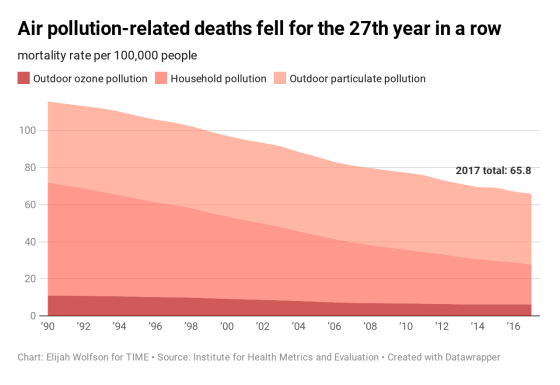
While at the same time, more and more people around the world gained access to electricity…
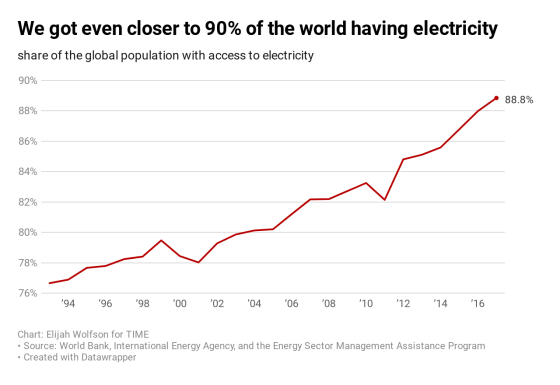
…and the share of energy coming from renewable sources reached an all-time high.
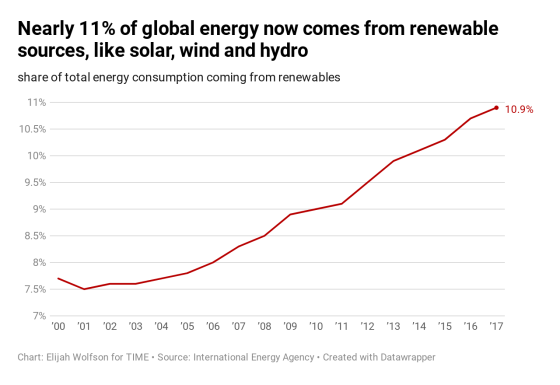
This good news is due largely to renewable energy becoming more and more price-competitive with fossil fuels; it’s getting to the point that many of the oil and gas majors are themselves investing in green energy. In 2019, such companies sealed some 70 clean-energy deals, according to Bloomberg data. And on the other side of the coin, investors are starting to rapidly divest from fossil fuels. An analysis undertaken by the environmental advocacy nonprofit 350.org found that assets of institutions now committed to divestment grew a ridiculous 22,000% from 2014 to 2019. Yes, you read that right:

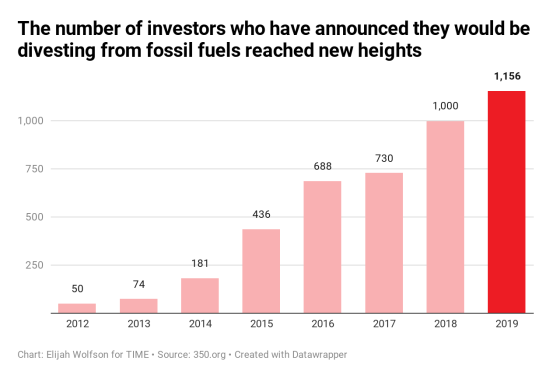
Again, there is a staggering amount of work still to be done, but these are encouraging signs of the world is starting to come to terms with reality.
Economic & Social Development
Access to the sorts of resources that enable people to improve their lives has, in general, expanded in the last year. Electricity is important, but safe drinking water is even more essential, and the latest data from the World Health Organization and the United Nations Children’s Fund show that a greater percentage of the world population has access to potable water than ever before.
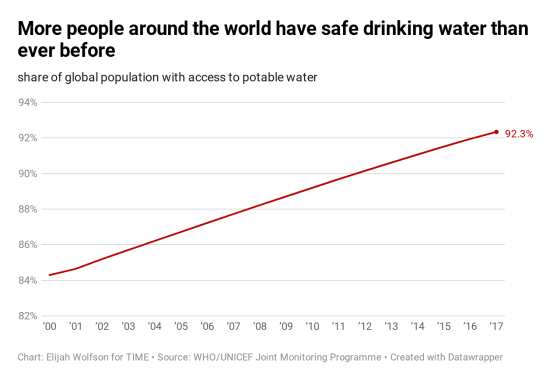
Though it can be very challenging to determine, on a global scale, who is rich and who is poor, and how wealth is distributed, most methodologies are in agreement: more working people have the financial means to live securely than at any other time in recorded history. The chart below tracks a metric that accounts for inflation, as well as the variation in expenses from country to country.
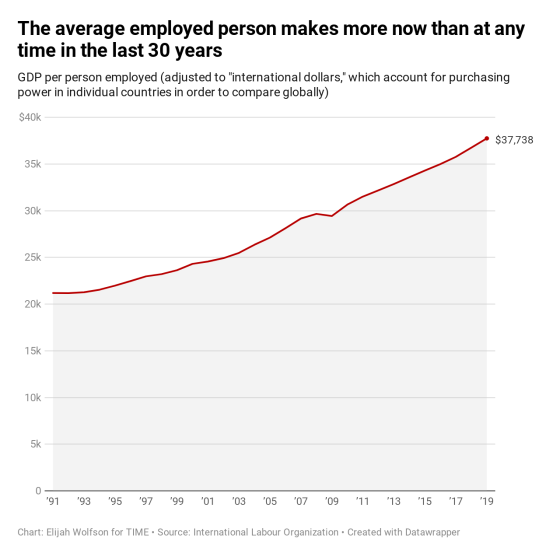
Access to health care, safe drinking water, reliable electricity, and financial capital all have a huge impact on one thing the majority of parents everywhere care about most: that their children can get a good education, and therefore, opportunities that they themselves didn’t have. So it’s no surprise as these other metrics continue to rise, so do the rates of global literacy—a fairly good indicator of overall education.
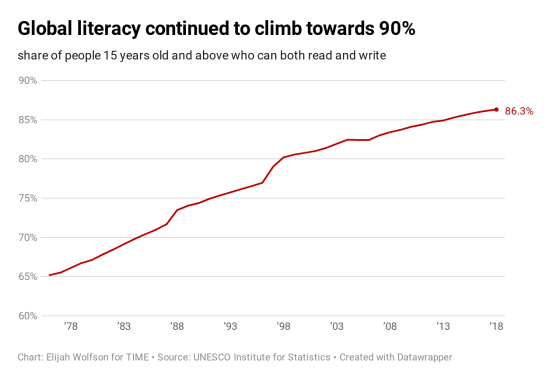
Similarly, students enrolled in primary schools across the globe finished their schooling at a rate higher than ever before.
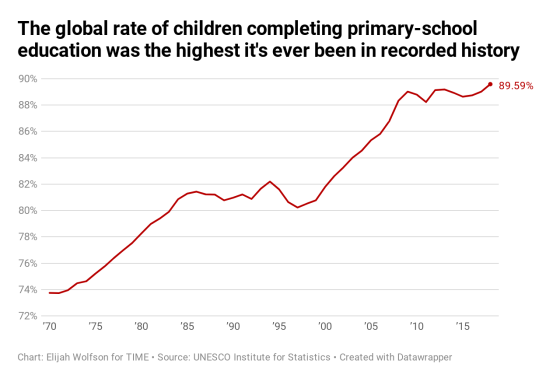
Gender Equality & LGBT Rights
Even better, the historic gap between male and female students finishing primary school continues to narrow, according to the UN Educational, Scientific and Cultural Organization:
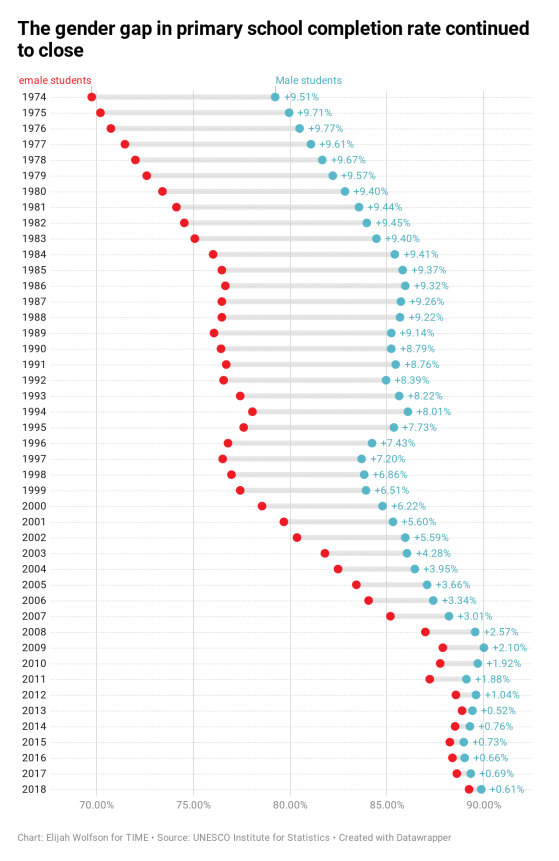
Other significant, ongoing advances in global gender equality can be seen in the data published over the last year. UN data show that fewer and fewer adolescent girls are being exploited by being married off and forced to have children in their teens, for example.
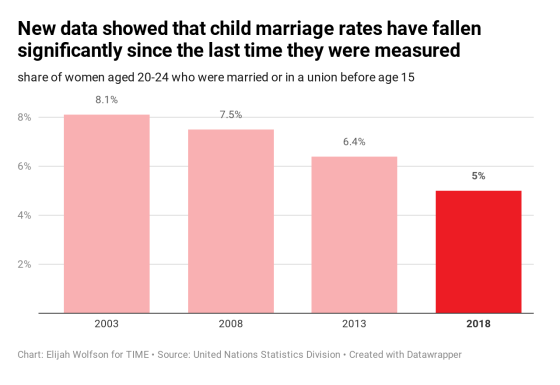

And, though there are still miles to go to achieve gender equality at the highest level, at the very least, electorates around the globe are continuing to wise up, voting a larger share of female legislators into office than in every year since these data have been tracked by the Inter-Parliamentary Union.

These are, of course, relatively meager gains, and there remains a massive global gender gap that, at current rates, the World Economic Forum predicts will take another 100 years to close. But at least the trend is in the right direction.
Health
Perhaps the most straightforward (if overly simplistic) way to assess total global health is to look at life expectancy. And on that front, the world appears very healthy indeed. According to the United Nations Population Division, a person born in 2017, on average across the world, could be expected to live to be 72.4 years old, the highest number in nearly six full decades of record-keeping.

One of the primary reasons for these ongoing improvements in long-term outlook is the widening dissemination of effective care models for newborns and for women throughout the course of pregnancy and delivery. Both infant mortality and maternal mortality rates reached new lows in their respective recorded histories (at least globally; the U.S. is unique in its failures on these fronts).

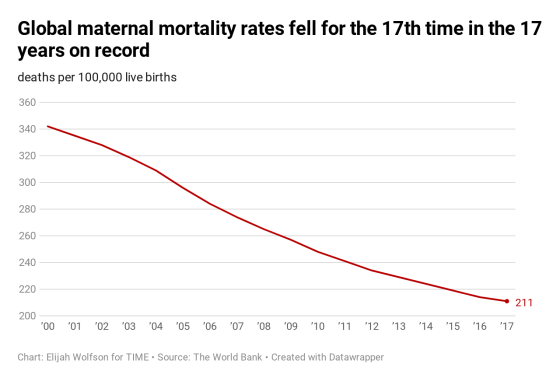
Another reason for the overall increase in life expectancy is that more and more people around the world are gaining access to essential health care services.
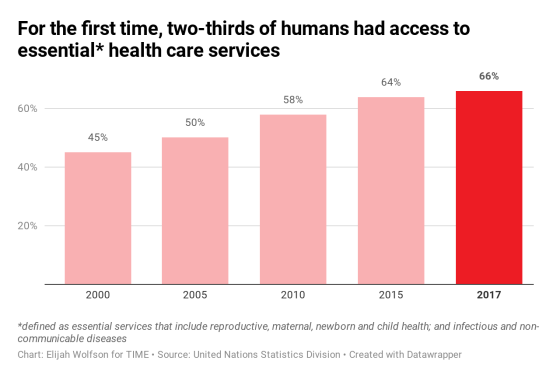
Of course, that means one-third of people still cannot get basic health care. But we are making real progress all the same.
Drilling down to the level of specific illnesses, one compelling example of recent successes in public health is the global response to AIDS/HIV, which has led to significant advances in both prevention and treatment. New HIV infection rates are at an all-time low, and the percentage of people with HIV receiving antiretroviral treatment is at an all-time high, according to UN data.


And for good measure, one last chart: while it’s true that more and more people are getting cancer every year, it’s also true that medical science has become better and better at treating this class of illness. In about 20 years, the global cancer mortality rate has fallen about 15%.

It’s one of many, many examples of the reality that the world has never before witnessed a time of such immense potential when it comes to human health.